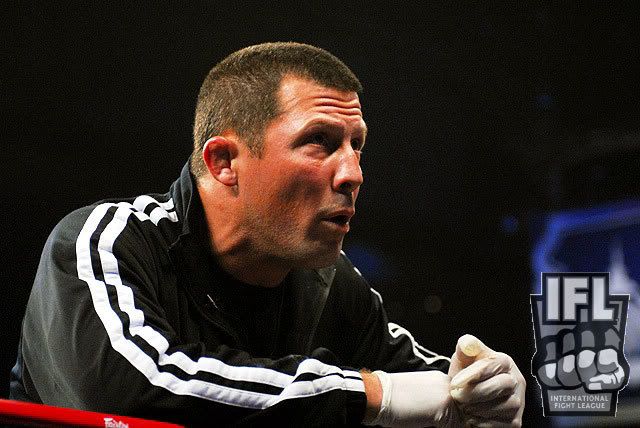Profit kick: FOX Takes Aim At UFC

By Melissa Segura/SI
Not much makes Pat Miletich say stop. The mixed martial artist has had his arms twisted, neck choked and body whacked by some of the toughest, strongest, meanest men in the world. But it was when his sport exploded in popularity, Miletich finally, as they say in mixed martial arts, tap out.
A cult hero in mixed martial arts circles (or in this case, rings), Miletich has run a franchise of mixed martial arts (MMA) schools across the country. When the number of academies bearing his name hit 60, "I had to put the brakes on it," he said.
The sport, though, shows no signs of slowing down as it chases football, basketball and baseball in capturing the attention, not to mention the dollars, of American men between the ages of 18 and 34. While everyone from Massachusetts Senator John Kerry to this reporter closely monitored the proposed agreement that would allow DIRECTV to exclusively air out-of-market Major League Baseball games, an equally important, if not potentially more profitable, deal was struck this winter between the newly-formed International Fight League (IRL) and FOX.
The International Fight League attempts to mainstream a sport previously known for it's caged matches and bloodied participants by eliminating the steel frames encasing the ring, kicks to the groin and elbows to the face that left many viewers nauseous. Notably, the IFL has adopted a team-versus-team model rather than fighter-versus-fighter. FOX will air this new format on network television via its MyNetworkTV starting Monday at 8 p.m. (ET/PT) under the title "International Fight League Battleground".
Mixed martial arts flexed its financial muscle last October when a a fight broadcast on cable drew a reported 1.6 million 18- to 34-year-old men, 5,000 more than those watching FOX's broadcast of the Detroit Tigers-Oakland Athletics playoff game.
The Ultimate Fighting Championships (UFC), the granddaddy of mixed martial arts leagues, proved the potential and profitability of the sport. Exactly how profitable is still in question, though, since the league is notoriously zip-lipped about its finances, but know this: $750 ringside seats are snatched up in a hurry and of the top five pay-per-view events in 2006, two were UFC events, generating more than $52 million in revenue. Tapout Clothing, a line of apparel featuring famous mixed martial artists has doubled its profits every year since 1998, according to the company's CEO Charles Lewis, or "Mask", as he's known in the sport's community.
Although the UFC has had a choke hold on the sport all along, the IFL hopes to hook its audience in a number of strategically different ways.
First, the team concept. Just as there is no "I" in team, there isn't one in money, either. The league features 12 teams of five fighters based in major markets across the country (New York, Chicago, the Quad Cities, Seattle, Portland, San Jose, Los Angeles, Southern California, Nevada and Tucson) and two abroad (Toronto and Tokyo) coached by legends of the sport such as Renzo Gracie, Ken Shamrock and Miletich. The teams will fight a nine-event schedule, culminating in a semifinal bout on Aug. 2 at New Jersey's Meadowlands and a final bout on Sept. 15 in Los Angeles' Forum.
"It's difficult to build products that were based on a single individual," says Gareb Shamus, co-founder and CEO of the fledgling league. "You get wider distribution and wider appeal when you're dealing on the team side of it."
The team concept is one aspect that convinced Miletich, coach of the Quad City team, to join the league because it allows the fighters to develop without the overwhelming fear of losing a match, and then their livelihoods. "By doing the team concept, it's impossible for an organization to use up a guy and throw him out like a piece of trash," Miletich says. The IFC is also generating good will among the fighters by offering them a stipend and health insurance.
Drawing on famous fighters such as Miletich offers another significant advantage for the IFL: a pipeline of talent and fans. Since most famous fighters/coaches have their own academies across the country filled with hundreds of students who interact with the celebrities of the sport on a regular basis, a natural affinity builds between the fighters and the fan base. The IFL pushes the interface between the recreational participants and the pros as one of its major selling points.
"The cool thing about this sport is that I can't go and practice with the Dallas Cowboys or the Chicago Bulls, but if a guy who's an orthopedic surgeon gets good enough, then he's rolling around and competing pretty well [with the sport's top fighters]", says Miletich. "It's pretty powerful when the fan base can actually do the sport."
And who makes up this fan base? According to a recent article in The Wall Street Journal, a great number of participants are Wall Street types looking for the competitive and physical challenges posed by MMA. That connection to the nation's financial heart plays right into another IFL strategy: being a publicly traded company.
Unlike the UFC, the IFL opted to place its business on the open market. "By appealing to the business world, we're appealing to our audience," Shamus says.
When the stock, traded under (OTC.BB: IFLI), hit the market in December, it went for just under $3 per share. As of Thursday morning, the price had more than tripled to $9.66 per share. The IFL also created stock incentives for the fighters and thereby gave them a vested interest in the performance of the stock.
After a Minnesota investment bank helped raise more than $24 million to launch the IFL, FOX chipped in an additional $6 million. The IFL format, which is broken down into three, quick, four-minute rounds, plays perfectly into new digital media. FOX, which owns the digital rights, will be able to stream the fights on its other properties, like MySpace. "We have access to all of [FOX's platforms]," Shamus says.
The one thing the IFC doesn't have access to are fighters not on the IFC circuit. Should the IFL take off and match the UFC in popularity, the rift between the two leagues could prevent fans from seeing the best IFL fighters compete against the best UFC fighters.
At this point, though, Dana White, president of UFC, remains unconcerned about the emergence of other leagues. "There are no competitive leagues," he says. "All of the other shows out there are just feeders to the UFC." The primetime ratings from the IFL in the coming weeks will tell if they'll be tapping out or tapping into the money pit that is the MMA ring.
(Source)






















No comments:
Post a Comment